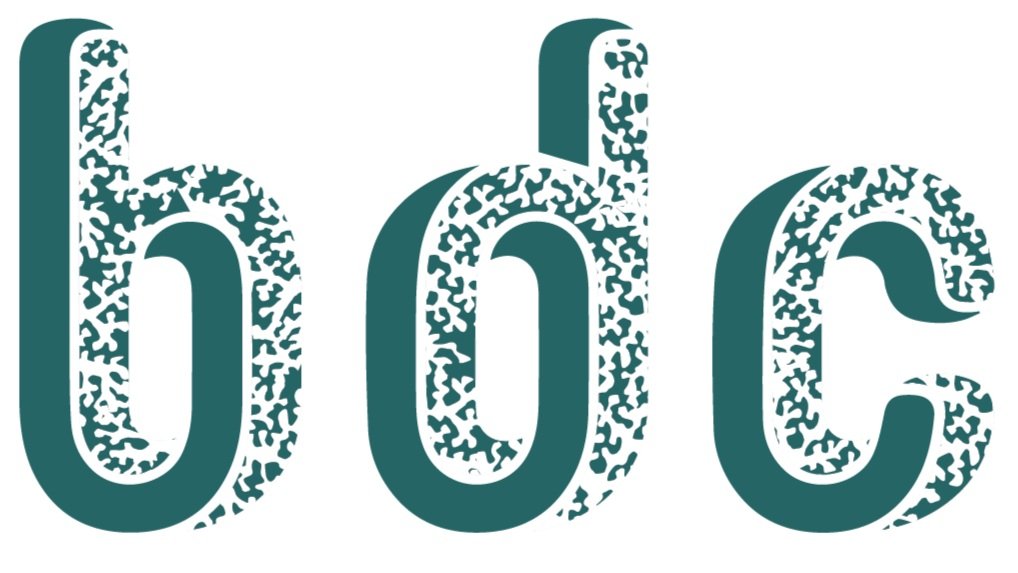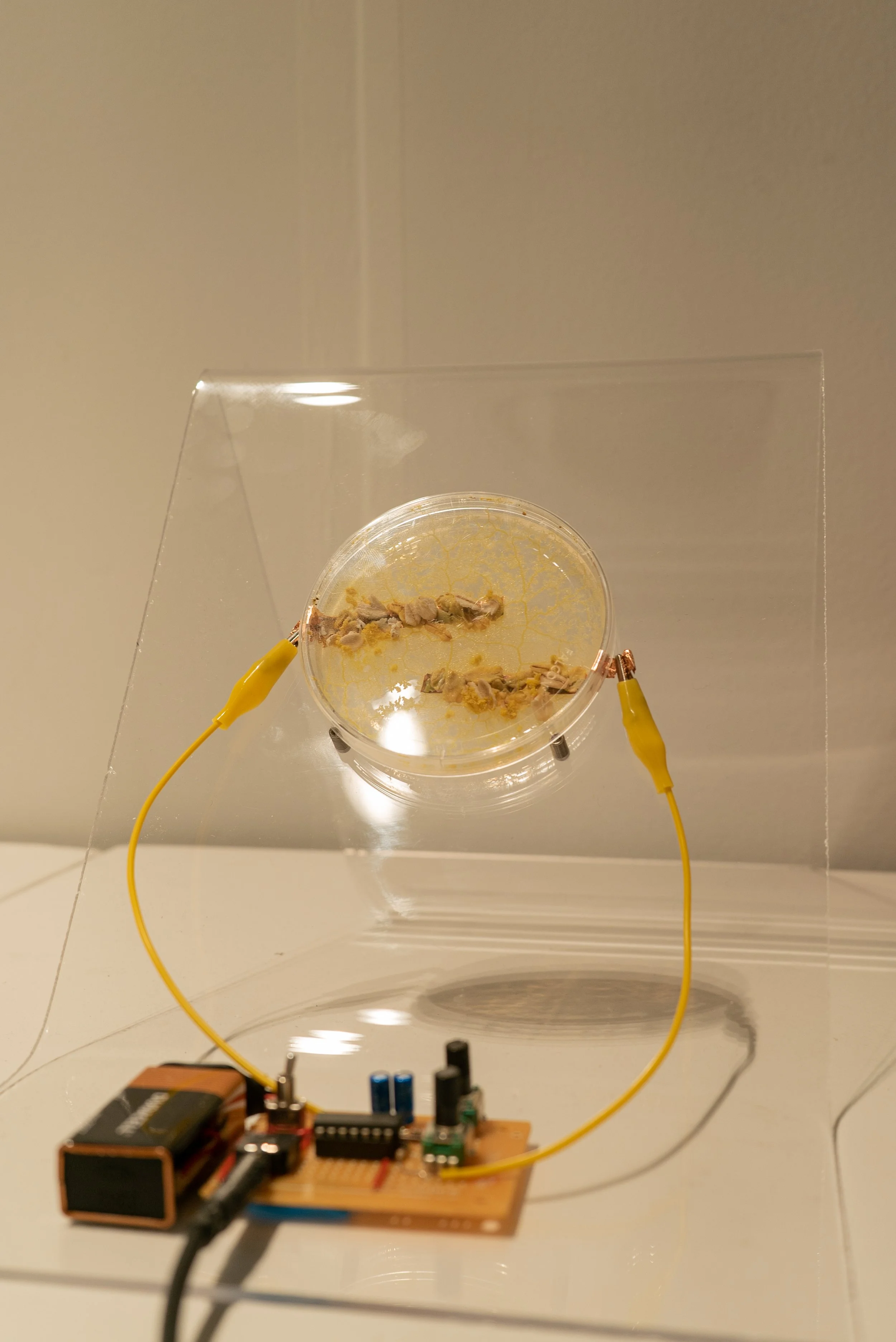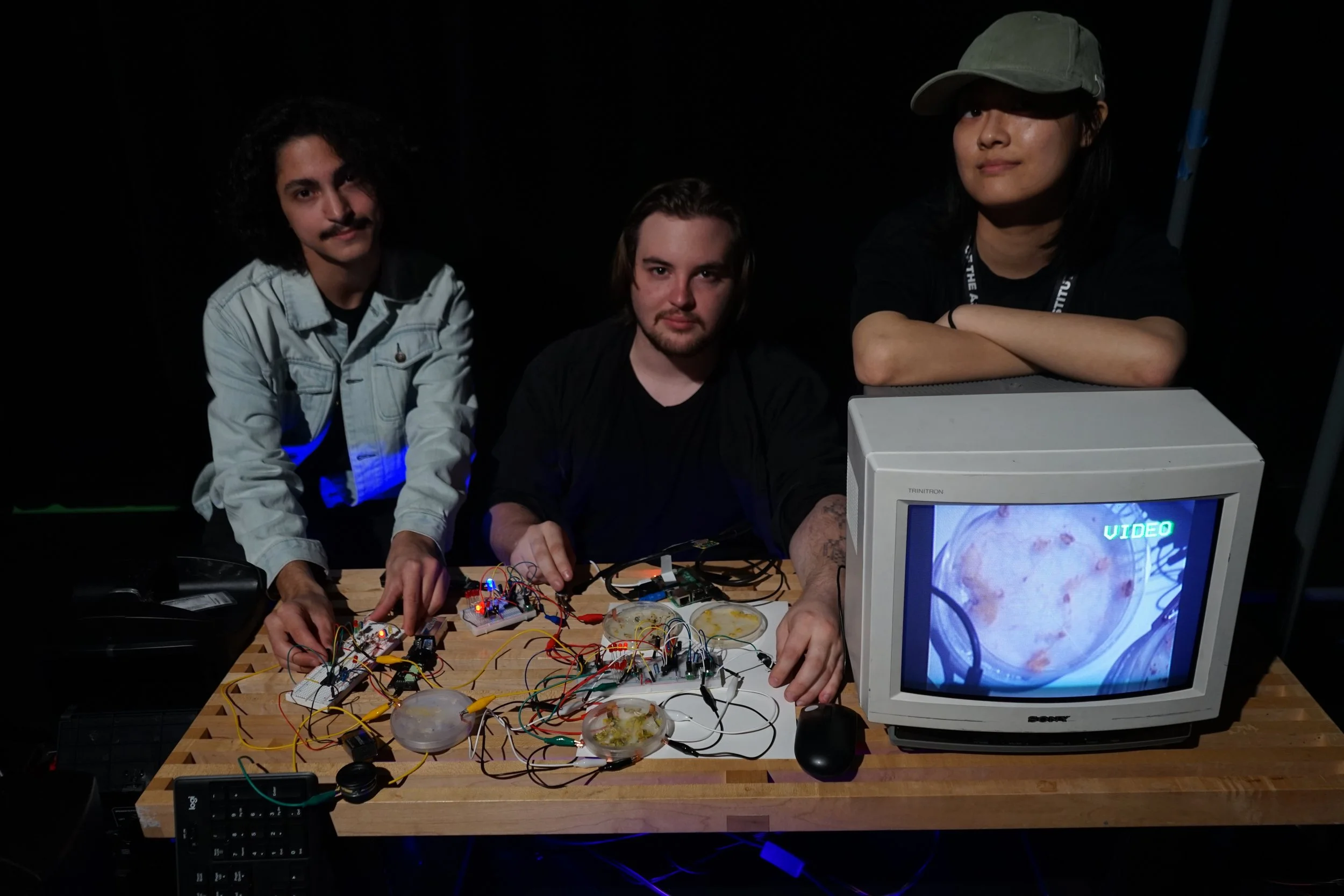SlimeVolt, BDC 2022, School of the Art Institute of Chicago
This edition of Alumni Voices features SlimeVolt, a team from the School of the Art Institute of Chicago (SAIC) that participated in BDC 2022. The SlimeVolt team includes Yousif Alzayed, Yimei Zhu, Ben Glass, and Ryan Garvey. SlimeVolt recently showed their project at Expo Chicago, an international contemporary and modern art exhibition held each year in Chicago, Illinois.
Yousif is pursuing a Master’s of Art and Technology Studies at SAIC. His research spans across physics, chemistry, and biology, and focuses on the integration of analog and digital electronics as an art material.
Yimei holds a Master’s degree in Art and Technology Studies from SAIC. She is an experience-oriented creator who focuses on Art, Disability, and Posthuman Bodies. Her artworks discuss deficiencies and imperfections seen through an unconventional perspective and resist stereotypes that accompany disability.
Ben is pursuing a Master’s of Art and Technology Studies at SAIC. He is an interdisciplinary artist whose work explores the convergence of technology, biology, and the post-human body, delving into the essence of humanity and living organisms in a world inherently intertwined with technology and embodied virtuality.
Ryan is a composer and performer who uses improvisation, transcription, electronics, and rhythmic grids to create music that asks the listener to expect the unexpected. He is pursuing his Ph.D. in Composition at the University of Chicago and his research takes form by way of extended techniques, exploration of color through the medium of electronics, and the phenomenology of perception.
Could you give a brief introduction to slimevolt? how did the idea for the project come about?
SlimeVolt seeks to incorporate biological components within electronic systems as a way to rethink human relationships with electronics. As a group, we were inspired by the idea of collaborating with living organisms through electronics, and wanted to create a bridge between the two worlds as a method for artmaking. We were each drawn to the organism Physarum polycephalum (aka Slime Mold) for its unique qualities of memory and intelligence. Musical instruments became our exploratory tool into the world of electronics, and provided us a gateway into simple circuitry that we could interject our Slime Mold into. As we amplified these sounds, we noticed that our playful interaction had developed into a routine for care with our co-collaborator.
What questions or problems did your team explore during your research process? And what led your team in the direction of addressing the relationship between organisms and electronics?
We found that by interfacing slime mold with electronic musical instruments we could immediately open up new channels of communication between ourselves and the organism. In doing so, we replace the current predictability of computing with a biological spontaneity found in the natural world, challenging societal norms around the need to constantly update and replace our everyday devices. SlimeVolt envisions a future where you are able to build a personal relationship with your electronic infrastructure. SlimeVolt challenges our relationship with technology by incorporating biological components into our systems to foster a caring relationship with electronics. We feel that the trajectory of computer systems is highly consumptive and energy-dependent; we promote physical systems with biological components to look towards nature on a small and personal scale.
Where do you find inspiration, biodesign-adjacent or otherwise?
Andrew Adamatszky and Eduardo Miranda have been initial and consistent sources of inspiration, particularly Adamatszky’s text Advances in Physarum Machines, which documents over 10 years of his own and others' research into Slime Mold, even listing his thoughts on its uses in art and music experimentation.
WHAT core VALUES DO you prioritize in your design practice? How do they manifest in your projects?
We believe in the reincorporation of technology into our post-human relationship with nature. We reject the view of technology as separate from nature and instead seek to create systems rooted in care. We insist on reducing the harmfulness to living things and eliminating the environmental hazards caused by biological materials. At the same time, we use low-cost, second-hand, recyclable materials in lieu of expensive customized materials.
How do you imagine SlimeVolt being used in the future? What do you see as the next steps for SlimeVolt?
By embracing the natural rhizome, we can liberate electronics from the limitations of the binary to create tools for artists that are both sustainable and equitable. Sharing instructables online and a detailed DIY explanation of the piece feels like the final chapters for us within our online presence. For our personal art practices, we’re interested in attempting more installation and sonic based projects, one of which will be an array of spatial audio/multi channel speakers.
Did your experience with BDC inform the way you design today?
Absolutely. In the future as we think about bringing creatures as a creative medium into exhibitions and performances, we will consider bioethics and the complexity of co-creation as artists in the face of environmental pollution and impacts on biodiversity.
In the course of the competition we also discovered the importance of depicting hope. This competition is not only a test of academics, creativity, and teamwork, but also a space for young people to envision the future and inspire people from all walks of life to move towards a common goal.
Do you have any advice for future BDC participants?
Spend as much time within the class utilizing your peers and instructors as valuable assets for your project. Also, don’t be afraid to reach out to professionals in your desired fields of research as the BDC framework provides a wonderful lens to approach people. Lastly, be sure to document all the things that you attempt—every iteration, sketch, notes—all of these stepping stones can be useful when compiling your journey together at the end of the course.






